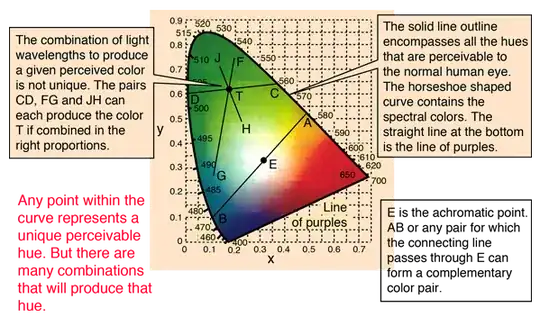Given the sun as the source of light for the above question, does the incident of different visible wavelengths same on a given surface, at a particular time and duration, even if the sun is rotating at a constant speed.
1 Answers
A ray is a geometrical definition of the direction of classical light waves:
In optics a ray is an idealized geometrical model of light, obtained by choosing a curve that is perpendicular to the wavefronts of the actual light, and that points in the direction of energy flow.
Thus the content in frequencies/wavelengths of a ray is the same as the content in the mathematical description of electromagnetic waves.
The colors of the spectrum are not one to one with the colors our eyes have defined. The spectrum from a crystal have specific frequencies that we have named with the color we see, and there, there is a one to one correspondence, frequency to color. Note there is no "white" in the spectrum:
But our eyes can see the same named colors with a combination of light frequencies, called color perception:
The color perceived at point T , comes from a combination of frequencies, and many different pairs give the same perceived color. White in this plot is around the achromatic point. Please read the link for details.
In summary, white is not a color in the visible light spectrum, many frequencies could make up the perception of white color, which means that photons of a large variation in energies make up the white color.
At the quantum level, light is a confluence of zillions of photons that combine to give the classical electromagnetic wave, for references see this.
The figure shows how the frequencies combine to give the perception of white. One needs many photons for our eyes to be able to perceive them, but even a few hundreds can give a signal to the brain, this link might interest you.
The answer your "What is the distribution of different wavelengths in single ray of white light?" is:
The distribution is not unique to give the perception of white light. There are very many frequencies/wavelengths as seen in the plot that will give "white". It will depend on the production mechanism.
If the light front started as white from the sun, and if it does not interact with any particles or fields on the way, the phases between the different frequencies/waves will be fixed, so it will arrive with the perception of white light with the same frequency/wavelength distribution it started with, still giving the perception of white. .
- 236,935

